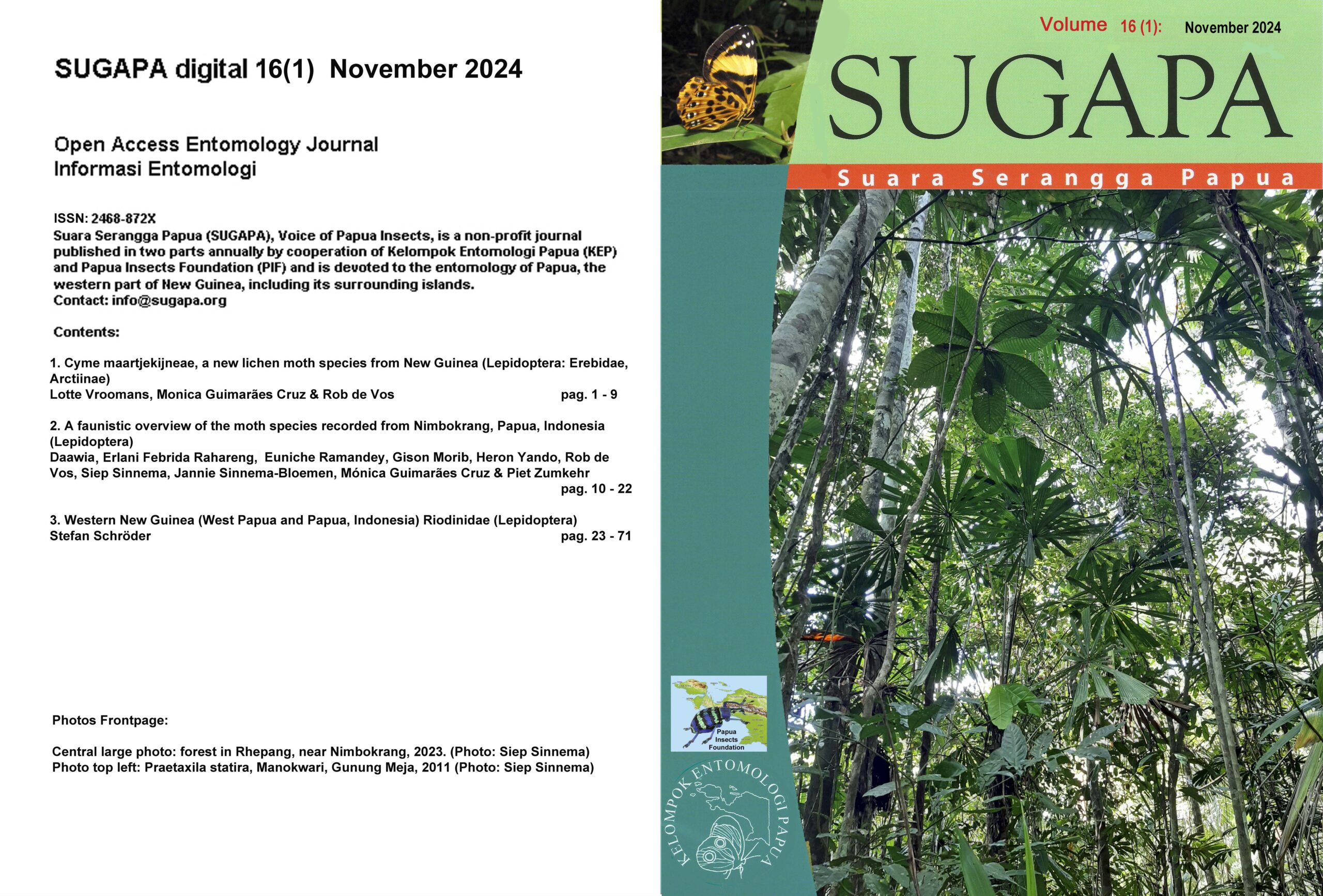Preparation of manuscript
Heading: Give title, full name(s) of author(s) [surname(s) in capital letters], and place of work with full address including e-mail address if available, each on a separate line. Title should omit authors of taxa and years of description, and, where appropriate, should contain names of higher taxa accommodating the insects under study, typically order and family, e.g., (Diptera: Muscidae).
Key words: Select a set of key words (index terms). The set should be complete (i.e., words from the title should be repeated if considered index terms).
The abstract should summarize the contents of the paper and indicate the relevance of the work. Adopt standard scientific nomenclature, avoid abbreviations and quotations. Abstracts of taxonomic papers should mention all nomenclatural acts and list newly proposed nominal taxa.
The standard order of sections for original papers is: Introduction, Material and methods, Results, Discussion (the last two sections may be combined), Acknowledgements, References, Footnotes, Tables, Figure legends. Use footnotes sparingly, and number them consecutively throughout the text. Each genus- and species-group name mentioned should appear at least once (preferably when first used, or in Material and methods) in connection with its author (plus year of description in taxonomic papers), but do not quote the author on each occasion. Do not abbreviate authors’ names. Interpret specimen labels and geographical data consistently throughout the paper, using current spelling of geographical names. If for some reason (primary types or other important specimens, difficult interpretation, incomplete data) you want to quote a label, place these data between quotation marks. Use British Standard System for the transliteration of Cyrillic characters (available from the editors on request).
References: (a) Within the text: Tröster (1990); (Lawrence, 1992); Brothers & Finnamore (1993); Enghoff et al. (1993). All publications referred to in the text (including synonymical lists of taxonomic papers) must be cited in full in the list of references. (b) Under References: Put authors in alphabetical sequence, with multiple papers of the same author arranged chronologically. Cite up to 10 authors (followed by “et al.” if the publication has more than 10 authors) and full title. Do not capitalize authors’ names. In journal articles, separate title and journal’s name by an m-dash (—) (see examples below). Abbreviate names of periodicals basically according to the World List of Scientific Periodicals, 4th Edition, Butterworths, London, 1964–1965 (if you are not certain about the correct abbreviation, give the journal’s name in full). Examples:
1. Standard paper in a continuously paginated journal; give issue number (in parentheses following volume) if each issue is paginated separately:
Enghoff H., Dohle W. & Blower J.G. 1993: Anamorphosis in millipedes (Diplopoda) – the present state of knowledge with some developmental and phylogenetic considerations. — Zool. J. Linn. Soc. 109: 103–234.
2. Papers from journals in which each article is paginated separately:
Tröster G. 1990: Der Kopf von Hybophthirus notophallus (Neumann) (Phthiraptera: Anoplura). Eine funktionsmorphologische und konsequent-phylogenetische Analyse. — Stuttg. Beitr. Naturk. (A) No. 442, 89 pp.
Number of pages is required also for online journals which do not include pages in their own suggested citation mode:
Regier J.C., Mitter C., Zwick A., Bazinet A.L., Cummings M.P., Kawahara A.Y., Sohn J.-C., Zwickl D.J., Cho S., Davis D.R. et al. 2013: A large-scale, higher-level, molecular phylogenetic study of the insect order Lepidoptera (moths and butterflies). — PLoS ONE 8(3): e58568, 23 pp.
3. In a book citation, capitalize words in title, give publisher (or “By the author” if self-published), place and number of pages:
Lawrence P.A. 1992: The Making of a Fly. The Genetics of Animal Design. Blackwell Scientific, Cambridge, MA, 228 pp.
4. Cite a book chapter as follows:
Brothers D.J. & Finnamore A.T. 1993: Superfamily Vespoidea. In Goulet H. & Huber J.T. (eds): Hymenoptera of the World: An Identification Guide to Families. Agriculture Canada, Ottawa, pp. 161–278.
5. Conference proceedings/articles should be cited as books/book chapters (i.e., with editors if stated on the publication, publisher and place), not as periodicals:
Wolf K.W & Bastmeyer M. 1990: Double spermatogenesis in Lepidoptera: Strain-specific differences in the apyrene meiosis of Ephestia kuehniella Z. In Hoshi M. & Yamashita O. (eds): Advances in Invertebrate Reproduction 5. Proceedings of the Fifth International Congress of Invertebrate Reproduction, Nagoya, Japan, July 23-28, 1989. Elsevier, Amsterdam, New York, Oxford, pp. 523–529.
6. Unpublished theses should be cited as follows:
Marinoni R.C. 1979: Contribuição a Sistemática de Lamiinae (Cerambycidae, Coleoptera). Unpublished doctoral thesis, Universidade Federal do Paraná, Curitiba, vi+147 pp.
7. Titles of publications in languages other than English, German, French, Spanish, Portuguese, and Italian should be replaced by an English translation, with an explanatory note at the end, such as [in Chinese, English abstract]:
Ivanova-Kazas O.M. 1981: Comparative Embryology of Invertebrate Animals. Atelocerata. Nauka, Moscow, 208 pp. [in Russian].
8. Web sites should be preferably avoided as source of cited data because the material is unpublished, may change frequently and the sites often do not backup/provide access to previous versions. Cite respectable well-established online data sources as follows. When author(s)/editor(s) are available (if the source appears in clearly defined numbered versions, you can provide just a general link to the entire site and the date of last access is not required):
Aarvik L.E. 2013: Tortricidae. In Karsholt O. & Nieukerken E.J. van (eds): Lepidoptera, Moths. Fauna Europaea Version 2.6.2. URL: http://www.faunaeur.org.
When author(s) are not available (e.g., if the site is maintained by the user community – please avoid citing such sources unless you have very strong reasons to do so) and/or the source does not appear in clearly defined numbered versions:
Biological Library 2016: Family Longhorn Beetles, Cerambycidae Latreille, 1802. URL: http://www.biolib.cz/en/taxon/id10991/ (last accessed 4 Jan. 2016).
Use italics as follows: In the text: Latin names of taxa up to the genus level (but not other Latin words or abbreviations such as “et al.”, “s. str.” etc.). In the References: Latin names of taxa, names of periodicals and titles of books. If your software has that option, use the Small Capitals typeface for author names in the list of references (but never type them in capitals from your keyboard).
When preparing illustrations and tables, please consider the journal’s page size, which is 170×247 mm, column width 82.5 mm. Illustrations (including graphs) and their caption or legends should form a separate, fully self-explanatory unit. Explain abbreviations in the legends, or (if too numerous) collect them elsewhere in a list (preferably under Material and methods). Do not use very fine lines or dots in drawings that are to be significantly reduced (in computer lineart files, lines and dots should be at least three pixels wide at print size). Illustrate fine details separately sufficiently enlarged and do not include them in overviews which must then be printed oversized. Illustrations should be arranged into blocks or plates by the authors. Use pre-printed or computer lettering of sufficient size to permit reduction. Photographic prints are best submitted at the actual size of reproduction. If the editors are to insert the final lettering, indicate your requirements on a printed copy. Morphological illustrations (if not schematic) should include scale bars. Tables should include headings and explanations, and should be numbered consecutively. Approximate position of figures and tables should be indicated in the manuscript. References in the text to illustrations and tables: Fig. 1; Figs 1–3; Table 1.

 Open Access Entomology Journal
Open Access Entomology Journal


